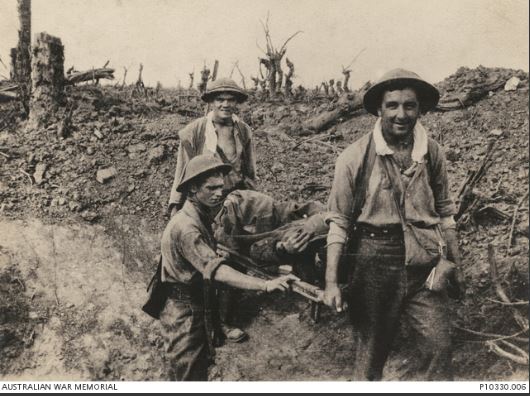12th Field Ambulance
From Our Contribution
 Three stretcher bearers from 12th Field Ambulance carrying out a patient at Pozieres. Australian War Memorial - Accession Number P10330.006 | |
 Shoulder patch | |
Contents
Brief History
A Field Ambulance was a complete medical unit made up of previously separate and independent entities. These were The Bearer Division [previously working as Bearer Companies]; The Tent Division [previously working as Field Hospitals] and The Transport Division. At full strength it composed of 10 Officers and 224 men. The Bearer Division had 18 stretcher squads each of 6 men. The Tent Division was comprised of doctors: 9 medical officers and 1 dental officer, as well as 1 Quartermaster of stores, batmen, clerks, cooks, dispensers, nursing orderlies, and the Transport Division, which had 60 men attached from the Army Service Corps. All this made up medical support for one infantry brigade. [Three to every Division].
Casualties would be hand carried - requiring at least four men but more like eight over any distance for each casualty. Hand carts were also used but rough ground generally meant stretchers. When an attack or advance was undertaken, the RAP would follow up the units' forward elements and were thus exposed to enemy direct fire (rifles and machine guns) and indirect fire (artillery mortar fire and even gas). The Field Ambulance would have personnel deployed forward to retrieve casualties from the RAP to the Field Ambulance. Battalion RAP were generally not accessible by vehicles so the Field Ambulance might deploy a number of different means to evacuate their charges. including hand carrying, small hand drawn wheeled carts horse drawn and motor transport. Their mission was to get the casualties to an Advanced Dressing Station or to a Casualty Clearing Station (CCS), or to the Field Ambulance's own facility which contained a small number of hospital beds and where emergency surgery could be performed. Casualties did not generally stay long, and they would be prepared for further evacuation through the medical support chain. This could entail evacuation to a major Field Hospital by ambulance train, or perhaps right back to Boulougne for transhipment to the United Kingdom.
The 12th Field Ambulance was the Field Ambulance Company that nominally supported the 12th Brigade although it was in fact under command of the Fourth Division, as indicated by the Colour Patch's circle shape. The 12th Brigade had been raised in Egypt by splitting the Battalions of the 4th Brigade, and was comprised of the 45th (NSW), 46th (Vic) 47th (Qld), and 48th (SA/WA) Battalions.
Thirty one men died while they were posted to this unit, two in Australia and 29 in France and Belgium as a result of enemy action.
Unit Personnel
- Jesse Thomas Manser 29 Feb 1916 - 24 May 1917
- Thomas Carberry MM MID 29 Feb 1916 - 14 May 1917
Patients
- Joseph Pulford 8 Feb 1917
- George Sidney Cook 13 Feb - 6 Mar 1917
- † Frank Leslie Sexton 16 Feb 1917
- Clyde Bird 16 Feb - 2 Mar 1917
- George Edward Binns 10 - 18 May 1917
- Leslie James Godfrey 10 -13 Aug 1917
- Ernest Camp 28 - 30 Mar 1918
- William Percival Nairn 28 Mar 1918
- Henry (Harry) Butcher 25 Apr - 2 May 1918
- Henry Joseph Milne 5 - 9 May 1918
- James Thomson MM 16 - 21 Jun 1918
Individual Honours
- 2 x Distinguished Service order
- 1 x Military Cross
- 1 x Bar to Military Cross
- 3 x Distinguished Conduct Medal
- 57 x Military Medal
- 5 x Bar to Military Medal
- 3 x Meritorious Service Medal
- 9 x Mentioned in Despatches
- 1 x Belgium Croix de Guerre
Notes
Content for the history and honours sections has come from a combination of Wikipedia and the Australian War Memorial websites.